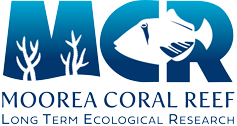Year:
2020
Authors:
Source:
M. S. Thesis
Abstract:
Ocean acidification (OA) negatively affects marine calcifying organisms and can alter many chemical and physiological processes. Crustose coralline algae (CCA), such as Porolithon onkodes, are important structural calcifying components on coral reefs and they grow across a range of depths. This research investigated the interactive effects of light quantity, spectral quality and pCO2 on P. onkodes to determine if CCA are impacted differentially by OA as a function of depth. In the first experiment, I tested the effects of increased pCO2 on Porolithon onkodes collected from two different depths. Light filters were utilized to simulate light quality at shallow back reef environments at 2-m depth and deeper fore reef environments at 17-m depth in manipulative mesocosm experiments at both ambient and elevated pCO2 treatments (400 μatm pCO2 and 1000 μatm pCO2). Results of this experiment showed no effects of OA on photosynthesis, respiration, calcification, or most photosynthetic pigment concentrations (except for phycoerythrin). Photosynthesis also did not differ between depths suggesting that photosynthesis in this species is not stimulated by blue wavelengths of light and may saturate at low levels of photon flux density (PFD). However, samples from shallow water calcified 64.7% faster than samples from the deep environment over the experiment, which is likely due to increased PFD and also indicates that photosynthesis and calcification may not be as tightly coupled as previously thought. The second set of experiments investigated the differences in photochemical efficiency of P. onkodes under OA conditions in a mesocosm experiment, and also by changes in algal orientation in relation to sunlight at different depths in a field experiment. The effective quantum yield of photosynthetic energy conversion (fluorescence yield), and the relative rate of electron transport through PSII (rETR) were quantified using a PAM fluorometer. Fluorescence yield was greatest in low-PFD environments in both the mesocosm and field experiments by 29.8% - 46.4% compared to the high-light environments. rETR were between 11.0% - 49.4% less than samples from high-PFD compared to low-PFD environments. OA at 1000 μatm pCO2 compared to 400 μatm pCO2 resulted in a decrease of fluorescence yield by 6.7% in the deep treatment, and by 21.7% in the high-PFD environment, which may be attributed to decreases in phycoerythrin pigment concentration. Overall, this study suggests that increased PFD is more important than spectral quality for P. onkodes, and although this study found no effects of OA on photosynthesis, respiration, or calcification rates, it did impact the concentration of the photosynthetic pigment phycoerythrin in low-PFD environments. Decreases in phycoerythrin in elevated pCO2 in low-PFD environments suggests that P. onkodes may be more impacted by OA in a fore reef compared to a back reef environment. Future studies should conduct longer experimental periods to determine if this pattern will ultimately result in decreases in photosynthesis and calcification.
Pages:
107 Pp.
Publication Type:
Thesis or Dissertation
Publisher:
Department of Biology, CSU Northridge



